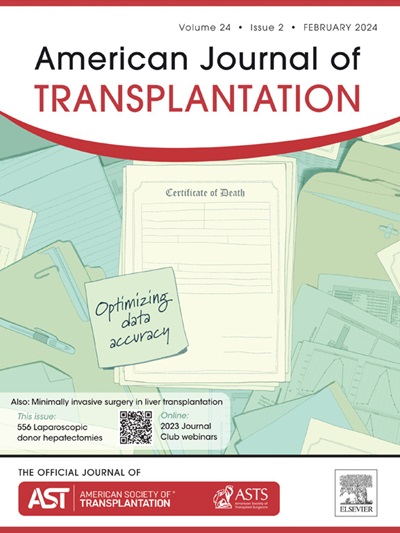OPTN/SRTR 2023 Annual Data Report: Liver
IF 8.9
2区 医学
Q1 SURGERY
引用次数: 0
Abstract
The number of liver transplants performed in 2023 in the United States reached another record high, totaling 10,659 overall, of which 10,125 (95.0%) were in adult recipients and 534 (5.0%) were in pediatric recipients. This growth was driven by increased recovery of livers from older donors and donation after circulatory death (DCD) donors—likely related to the wider availability of machine perfusion technologies. The overall nonuse rate, or percent of livers recovered for transplant and not transplanted, was 9.7%, a decrease from the preceding years, and 16.7% of transplant recipients accepted DCD livers. There was also growth in living donation, representing 5.7% of adult transplants and 14.6% of pediatric transplants. In July 2023, the model for end-stage liver disease (MELD) 3.0 and pediatric end-stage liver disease (PELD)–creatinine scoring systems were updated from MELD-sodium and PELD, respectively, and criteria for status 1B qualification for pediatric candidates were updated. A major goal of MELD 3.0 was to address the sex disparity in deceased donor transplant rates. In 2023, the gap in deceased donor liver transplant rates between sexes narrowed, although the rate remained higher for adult male candidates compared with female candidates, and pretransplant mortality rates were higher among adult female candidates compared with male candidates. Alcohol-associated liver disease and metabolic dysfunction–associated steatohepatitis remained the leading indications for liver transplant.

求助全文
约1分钟内获得全文
求助全文
来源期刊
CiteScore
18.70
自引率
4.50%
发文量
346
审稿时长
26 days
期刊介绍:
The American Journal of Transplantation is a leading journal in the field of transplantation. It serves as a forum for debate and reassessment, an agent of change, and a major platform for promoting understanding, improving results, and advancing science. Published monthly, it provides an essential resource for researchers and clinicians worldwide.
The journal publishes original articles, case reports, invited reviews, letters to the editor, critical reviews, news features, consensus documents, and guidelines over 12 issues a year. It covers all major subject areas in transplantation, including thoracic (heart, lung), abdominal (kidney, liver, pancreas, islets), tissue and stem cell transplantation, organ and tissue donation and preservation, tissue injury, repair, inflammation, and aging, histocompatibility, drugs and pharmacology, graft survival, and prevention of graft dysfunction and failure. It also explores ethical and social issues in the field.

 求助内容:
求助内容: 应助结果提醒方式:
应助结果提醒方式:


